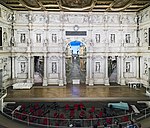Santa Corona, Vicenza
13th-century Roman Catholic church buildings in ItalyAndrea Palladio church buildingsGothic architecture in VenetoRenaissance architecture in VicenzaRoman Catholic churches in Vicenza

Santa Corona is a Gothic-style, Roman Catholic church located in Vicenza, region of Veneto, Italy. The church contains the Valmarana chapel (circa 1576), whose design is attributed to the Renaissance architect Andrea Palladio. Palladio himself was initially buried in this church.
Excerpt from the Wikipedia article Santa Corona, Vicenza (License: CC BY-SA 3.0, Authors, Images).Santa Corona, Vicenza
Contra' Santa Corona, Vicenza Santa Caterina
Geographical coordinates (GPS) Address Nearby Places Show on map
Geographical coordinates (GPS)
| Latitude | Longitude |
|---|---|
| N 45.549166666667 ° | E 11.5475 ° |
Address
Contra' Santa Corona 5
36100 Vicenza, Santa Caterina
Veneto, Italy
Open on Google Maps









